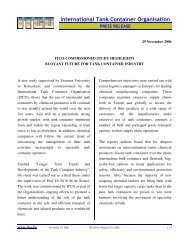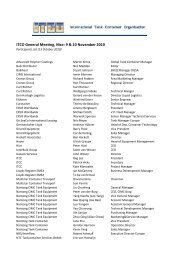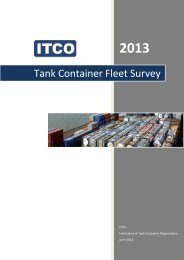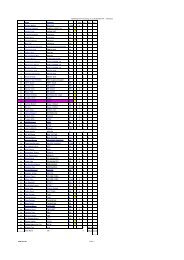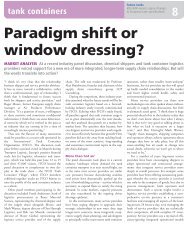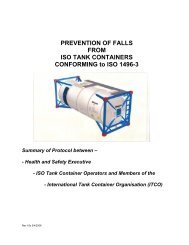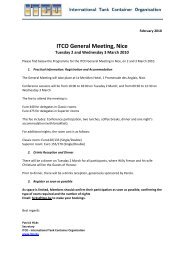Create successful ePaper yourself
Turn your PDF publications into a flip-book with our unique Google optimized e-Paper software.
ICHCA International <strong>Safe</strong>ty Panel Briefing Pamphlet No 30<br />
Picture 51 Picture 52<br />
11.8.2 Picture 51 shows two corner fittings stacked almost aligned and this should<br />
be the objective <strong>of</strong> all operators involved with handling all types <strong>of</strong><br />
containers and tank containers in particular. However the three other<br />
examples (pictures 52, 53 and 54) show that it is possible for the container<br />
stack to remain stable even though the containers are not positioned<br />
squarely above one another.<br />
Picture 53 Picture 54<br />
11.8.3 However the units, when stacked without their corner fittings aligned with the<br />
unit above / below, are being subjected to forces that they have not been<br />
tested against. Under the ISO 1496 series <strong>of</strong> standards, containers are<br />
tested with a 38 mm longitudinal and a 25 mm transverse <strong>of</strong>fset between the<br />
corner fittings. The risk <strong>of</strong> failure increases as the <strong>of</strong>fset increases.<br />
Therefore it is essential that all containers are stacked with the corner<br />
fittings aligned as closely as practicable.<br />
11.8.4 Many <strong>of</strong> the tank container units are fitted with incorrectly named “misstacking<br />
plates” as identified by the arrows in pictures 52 and 55. While<br />
these have been added to increase the surface area <strong>of</strong> the corner fittings<br />
they cannot be relied upon for supporting a stack <strong>of</strong> laden containers.<br />
11.8.5 The design and height <strong>of</strong> top and bottom rails on tank containers vary<br />
greatly. These components are not designed for stacking.<br />
11.8.5.1 Top rails, where present, are generally manufactured from 3 mm thick rolled<br />
hollow section tube. These are <strong>of</strong>ten only there as a means <strong>of</strong> connecting<br />
the walkway and are therefore only expected to support the weight <strong>of</strong> two<br />
men..<br />
11.8.5.2 The strength <strong>of</strong> the top rails and the even loads imposed by their height<br />
differentials means there is a risk <strong>of</strong> failure associated with stacking<br />
containers on these components<br />
Page 36 ©ICHCA International Limited



